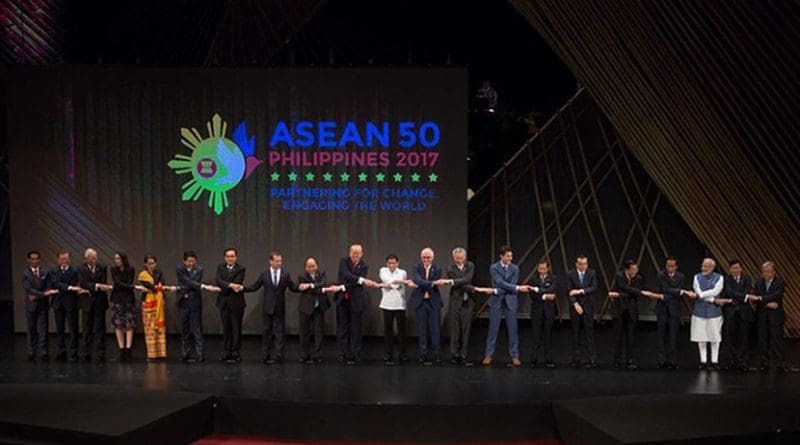What’s In A Name?: Strategy Behind The ‘Indo-Pacific’ – OpEd
By Published by the Foreign Policy Research Institute
By Felix K. Chang*
(FPRI) — Throughout his tour of Asia in November 2017, U.S. President Donald Trump repeatedly referred to the region through which he travelled not as the “Asia-Pacific,” but rather as the “Indo-Pacific.” While other American presidents have spoken of the “Indo Pacific” before, they did so infrequently. Trump’s continuous use of the term prompted some to speculate whether it offered a clue to the future of American strategy in the region.
Only a week later, Australia released a new white paper that embedded the term “Indo-Pacific” into its broad foreign policy objectives. The white paper made mention of the “Indo-Pacific” 74 times and the “Asia-Pacific” only four times. In contrast, Australia’s prior foreign-policy white paper, published in 2003, mentioned the “Asia-Pacific” 26 times and the “Indo-Pacific” not at all. Clearly, policymakers have intended the term to hold some deeper meaning.[1]
You Say “Asia-Pacific,” I Say “Indo-Pacific”
What does the term “Indo-Pacific” convey that the term “Asia-Pacific” does not? It conveys a wider view of the region to include the Indian subcontinent and, specifically, India. Why include India? Most likely it is because incorporating a country of India’s size and significance into the traditional conception of the Asia-Pacific region would help to balance the growing economic and military heft of China in it.
That makes sense, given that Australia, Japan, and the United States have already brought India into their Asian security discussions. Back in 2007, Japanese Prime Minister Shinzō Abe first suggested formalizing such a multilateral collaboration through what he called the Quadrilateral Security Dialogue. He hoped to bring together Asia’s four liberal democracies to promote their shared security goals. At the time, the concept fizzled for fear of alienating China. But that apparently is less of a concern today. With the rise of Chinese assertiveness, the four countries have begun to participate in joint military exercises all along Asia’s periphery. Since 2014, India, Japan, and the United States have conducted annual naval exercises from the Bay of Bengal to the Western Pacific. And, since 2015, Japan has joined the biennial Australia-U.S. military exercise called Talisman Saber.
Indo-Pacific Security Relationships
Still, for the moment the Indo-Pacific region’s only formal security alliances are the bilateral ones that link the United States with Australia, Japan, the Philippines, and South Korea in what some have described as a “hub-and-spokes” arrangement. The United States also has long-standing security relationships with Singapore, Taiwan, and until recently, Thailand. All other regional security ties are fairly nascent, including the one between Australia and Japan. Though both countries seem drawn to one another, their bond is not yet strong. Seen in that light, Australia’s recent decision to abandon a Japanese design for its future submarine fleet was probably a missed opportunity to reinforce that bond.
Meanwhile, India, which leaned towards the Soviet Union for much of the Cold War, has a relatively new security relationship with the United States. It was not until President George W. Bush orchestrated a civil nuclear deal with India, which implicitly recognized its nuclear weapons status in 2005, did that relationship really start. And even then, it did not grow quickly. Many Indians, including former National Security Council military advisor Prakash Menon and the former foreign secretary Shyam Saran, had reservations. In 2012, they, along with some notable Indian security experts, penned a strategy paper entitled Nonalignment 2.0 that downplayed the importance of stronger ties with the United States.[2]
Since then, however, China’s growing pressure on India’s borders and influence among India’s neighbors have made Indian leaders less concerned about India’s distance from the United States and more interested in finding common cause. As a reflection of that, India—once an exclusive Russian arms importer—has begun to acquire American military equipment and to consider Japanese ones, too. Australia specifically cited its interest in “much closer” ties with India in its recent foreign policy white paper.[3]
Indo-Pacific Encirclement of China?
For years, Chinese strategists have chafed at what they regarded as the geopolitical encirclement of China. But the number of such commentaries seems to have fallen over the last year or so. Perhaps that is because China has strengthened its relationship with Russia and made diplomatic headway in Southeast Asia. Or perhaps that is simply because China feels more powerful than it was. Ironically, China would have more reason to feel encircled today, if the other major Indo-Pacific powers choose to revive something akin to the Quadrilateral Security Dialogue.
What’s in the name “Indo-Pacific?” The answer, in this case, might be a strategy for balancing Chinese power in the region.
About the author:
*Felix K. Chang is a senior fellow at the Foreign Policy Research Institute. He is also the Chief Strategy Officer of DecisionQ, a predictive analytics company in the national security and healthcare industries. He has worked with a number of digital, consumer services, and renewable energy entrepreneurs for years. He was previously a consultant in Booz Allen Hamilton’s Strategy and Organization practice; among his clients were the U.S. Department of Energy, U.S. Department of Homeland Security, U.S. Department of the Treasury, and other agencies.
Source:
This article was published by FPRI.
Notes:
[1] Australia Department of Foreign Affairs and Trade, The Commonwealth of Australia’s 2017 Foreign Policy White Paper, Nov. 2017; and Australia Department of Foreign Affairs and Trade, Australia’s Foreign and Trade Policy White Paper, 2003.
[2] Sunil Khilnani, Rajiv Kumar, Pratap Bhanu Mehta, Prakash Menon, Nandan Nilekani, Srinath Raghavan, Shyam Saran, and Siddharth Varadarajan, Nonalignment 2.0: A Foreign and Strategic Policy for India in the Twenty First Century (New Delhi: Centre for Policy Research, 2012).
[3] Australia Department of Foreign Affairs and Trade, The Commonwealth of Australia’s 2017 Foreign Policy White Paper, Nov. 2017, p. 42.

